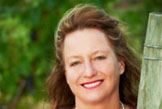 Wandering through my cellar last night, I pulled a bottle of Cullen's 1996 Cabernet Merlot from an odd bin. Upon pouring my first glass, I was less surprised by the seductive aromas of blackcurrant, ironstone and violet than the succulent fruit at such moderate levels of alcohol. Perplexed, I wrote to Vanya Cullen and received the following answer. Wandering through my cellar last night, I pulled a bottle of Cullen's 1996 Cabernet Merlot from an odd bin. Upon pouring my first glass, I was less surprised by the seductive aromas of blackcurrant, ironstone and violet than the succulent fruit at such moderate levels of alcohol. Perplexed, I wrote to Vanya Cullen and received the following answer.
Yes, Joel, the alcohol is only 13.5%. In fact, the earliest wines made at Cullen were only 12.5 to 13%. In particular, 1981 and 1982 are great examples of that style. Then we went on to riper tannins, which are still keys factor in quality red wine.
Before we began cultivating our vineyards biodynamically, our perception was that the tannins were only ripe at 13% and above. With biodynamics, the tannins are often ripen at 11% onwards, which gives us unforeseen options in terms of flavours, acidity and harvest times.
Although ripeness at lower levels of alcohol through biodynamics is something that we are still learning, we do note that Cabernet Sauvignon loses varietal definition at levels above 13,5%. The best balance seems to be somewhere between 12.5 and 13.5%, with 13% often being ideal.
My mother thus got it right instinctively as a winemaker back in the early 80s. Interestingly, the 1981 actually smells like the soil on the Diana Madeline block. More importantly, though, biodynamics is about sustainability. This way of farming has given us the potential to keep on producing wines of quality from this site for future generations.
Equally remarkable is the fact that the 1996 had only 40ppm SO2 total, which are natural winemaker's levels! I think that there was a softening of the tannins through the winemaking and barrel ageing stages because of this.
Now SO2 is all that we add to our wines. There is no yeast, no malolactic culture, no acidity and no fining of any kind. All wines are all harvested by hand and basket pressed, which also extracts only the finest quality tannins. I believe they are thus better representations of the site than before, when the influence of the winemaker was more apparent in some of the wines than the land. Comments |